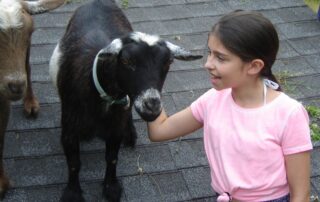 Pillar: Little Portion
Pillar: Little Portion
Laudato Si’ Action Plan Goals: Ecological Education, Adoption of Simple Lifestyles
 Pillar: Little Portion
Pillar: Little Portion
Laudato Si’ Action Plan Goals: Ecological Education, Adoption of Simple Lifestyles
Group (Grade Levels): 5th grade and up
- Learn how to sit and silently reflect upon our connection with nature
- Observe organisms in their natural habitats throughout the change of seasons
- Read and interpret signs in nature
Materials Needed: Natural place large enough for the group to spread out and be alone; journaling page (attached). Optional: binoculars, magnifying glass, towel to sit on
Estimated Time to Complete Activity: 45 minutes to 1 hour; 15–20 minutes for gathering and prayer; 15 minutes for performance of the activity in the first session, increased to half hour at the most; 15 minutes for integration
Estimated Number of Sessions if Activity Continues: Up to every day for a week, repeated in all seasons of the year.
Pre-planning
- Check over the area before bringing the group there. Be aware of any safety hazards as well as any delicate areas that should not be trampled. For children, it can help to have a physical marker of their space, such as a stake.
- Children can work in pairs in the little portion, but teenagers and adults should be solo.
General Outline of Experience
Scripture passage: “Praise the Lord” (Dan 3:52-90)
- How does nature praise the Lord?
- How do we praise the Lord?
Laudato Si’, n. 222: “To be serenely present to each reality, however small it may be, opens us to much greater horizons of understanding and personal fulfilment.”
- How does being in nature help us to listen and sit quietly with ourselves?
- How do we experience silence?
- How do we hear God’s voice?
- How does nature help us to experience God?
Experience from the life of St. Francis:
- Portiuncula – Explain what we mean by “little portion:” A Portiuncula is a little portion, a small place that we can call our own, where we encounter God in one another or in nature in a personal way. For St. Francis, it was one of the churches that he rebuilt and where he began to grow his community of brothers. The church was a gift to him and his brothers from a local Benedictine community. Do you think you have a Portiuncula in your life?
- Is a Portiuncula always a physical location, or can it be internal?
- Another example of a Portiuncula is the Carceri, a hermitage on the mountain above Assisi where St. Francis used to go for contemplation. How can you get away from your everyday routine to experience God’s presence?
- Do you have a way to relax and recharge to be able to face the world and your problems?
- For adults: What were your experiences in the outdoors as child?
- For children: What are your experiences in the outdoors?
- Do you think there was any plan in the way nature was developed? (Refer to the Creation stories in Genesis 1 and 2.)
- Explain how the activity will take place: each person will choose a space in the parameters of the area. They are to remain in that space for the allotted time, sitting quietly and observing the natural happenings around them. This is their “little portion.” Give safety guidelines and identify potential dangers such as poison ivy, etc.
- Give the students a brief tour so they know the boundaries and some of the characteristics of the area and can choose appropriate places for their “little portions.”
- Demonstration of how to use tools: Show the students how to use magnifying glasses and binoculars, if you will be using them.
- Give the students time to take their journals and any other observation tools out to their Portiuncula space and take the allotted amount of time (15 minutes to ½ hour, depending upon the age of the participant) in the Little Portion area. No cell phones or talking is to occur during this time, only quiet sitting and observation and reflection.
- As a group has more experience with their little portions, they will be comfortable spending more time there.
After each visit, give the students the opportunity to share with each other about their experiences.
- Discussion questions:
- Is there a place you could do this on your own? Your yard? Walking to school?
- How has this experience connected you with nature?
- How can that connection affect your life?
- Is this something you might continue on your own?
- Potential analogies:
- Take time to examine nature; take time to get to know people. We learn so much more about someone when we spend time with them. We could see just a thorn bush, and then look closer to see it has raspberries. If we don’t take time with a person and then get to know them, we will miss their “hidden treasures.” This is how we learn to reverence the “little portions” that are in other people and the natural world.
- Was there a time in your life when you found a particular “little portion” – a place that helped you find your centering and navigate through a challenging experience?
- Closing Prayer
- Close with a spontaneous prayer, modelling for the children how to talk with God about the experience and then allowing them to follow suit.
- End with the “Glory Be.”
- Write a cinquain poem
- Develop a prayer
- Write a paragraph about why this little portion is special to you
- Research an animal and determine whether it could live in your little portion
- What would you do if you wanted to improve the site? How be a steward?
- Litter pick-up, if needed
Cross-references to related experiential activities: Flower-Gazing and Poetry, Hiking and Nature Walks, Nature-Based Pilgrimage in Assisi




